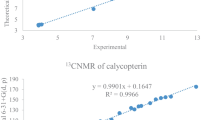Abstract
The metal-chelating activity of a series of 48 chromone compounds, evaluated by ferrous (Fe2+) chelating test, were subjected to 3D-QSAR studies using comparative molecular field analysis (CoMFA) and comparative molecular similarity indices analysis (CoMSIA). The best CoMFA model obtained from HF/6-31G* geometry optimization and field fit alignment gave cross-validated r 2 (q 2) = 0.582, non-cross-validated r 2 = 0.975. The best CoMSIA model gave q 2 = 0.617, non-cross-validated r 2 = 0.917. The resulted CoMFA and CoMSIA contour maps proposed the Fe2+-chelating sites of chromone compounds compared with those of quercetin.




Similar content being viewed by others
References
Bors W, Saran M (1987) Radical scavenging by flavonoid antioxidants. Free Radic Res Commun 2:289–294
Breinholt V, Hossaini A, Svendsen GW, Brouwer C, Nielsen E (2000) Estrogenic activity of flavonoids in mice. The importance of estrogen receptor distribution, metabolism and bioavailability. Food Chem Toxicol 38:555–564
Cotelle N (2001) Role of flavonoids in oxidative stress. Curr Top Med Chem 1:569–590
Cramer RD, Patterson DE, Bunce JD (1988) Comparative molecular field analysis (CoMFA). 1. Effect of shape on binding of steroids to carrier proteins. J Am Chem Soc 110:5959–5967
Dinis TCP, Madeira VMC, Almeida MLM (1994) Action of phenolic derivatives (acetaminophen, salicylate, and 5-aminosalicylate) as inhibitors of membrane lipid peroxidation and as peroxyl radical scavengers. Arch Biochem Biophys 315:161–169
Fiorucci SB, Golebıowski J, Cabrol-Bass D, Antonczak S (2007) DFT study of quercetin activated forms ınvolved inantiradical, antioxidant, and prooxidant biological processes. J Agric Food Chem 55:903–911
Gabor M (1986) Anti-inflammatory and anti-allergic properties of flavonoids. Prog Clin Biol Res 213:471–480
Golbraikh A, Tropsha A (2002) Beware of q 2! J Mol Graph Model 20:269–276
Gülçin I (2006) Antioxidant and antiradical activities of l-carnitine. Life Sci 78(8):803–811
Haenen GRMM, Jansen FP, Bast A (1993) The antioxidant properties of five O-(β-hydroxyethyl)-rutosides of the flavonoid mixture Venoruton. Phlebol Suppl 1:10–17
Harborne JB, Williams CA (2000) Advances in flavonoid research since 1992. Phytochemistry 55:481–504
Havsteen B (1983) Flavonoids, a class of natural products of high pharmacological potency. Biochem Pharmacol 32:1141–1148
Hu CG, Chen K, Shi Q, Kilkuskie RE, Cheng YC, Lee KH (1994) Anti-AIDS agents, 10. Acacetin-7-o-β-d-galactopyranoside, an anti-HIV principle from Chrysanthemum morifolium and a structure-activity correlation with some related flavonoids. J Nat Prod 57:42–51
Jesús O-V, Leonardo P-L (2002) Structure-activity relationships for the anti-HIV activity of flavonoids. J Chem Inf Comput Sci 42:1241–1246
Ji HF, Zhang HY (2006) Theoretical evaluation of flavonoids as multipotent agents to combat Alzheimer’s disease. J Mol Struct 767:3–9
Kalinowski DS, Sharpe PC, Bernhardt PV, Richardson DR (2008) Structure-activity relationships of novel iron chelators for the treatment of iron overload disease: the methyl pyrazinylketone isonicotinoyl hydrazone series. J Med Chem 51:331–344
Klebe G, Abraham U (1999) Comparative molecular similarity index analysis (CoMSIA) to study hydrogen bonding properties and to score combinatorial libraries. J Comput-Aided Mol Des 13:1–10
Klebe G, Abraham U, Meitzner T (1994) Molecular similarity indices in a comparative analysis (CoMSIA) of drug molecules to correlate and predict their biological activity. J Med Chem 37:4310–4346
Leopoldini M, Russo N, Chiodo S, Toscano M (2006) Iron chelation by the powerful antioxidant flavonoid quercetin. J Agric Food Chem 54:6343–6351
Maicheen C, Jittikoon J, Vajragupta O, Ungwitayatorn J (2013) Synthesis, topoisomerase I inhibitory and cytotoxic activities of chromone derivatives. Med Chem 9:329–339
Morel I, Lescoat G, Cogrel P, Sergent O, Pasdeloup N, Brissot P, Cillard P, Cillard J (1993) Antioxidant and iron-chelating activities of the flavonoids catechin, quercetin and diosmetin on iron-loaded rat hepatocyte cultures. Biochem Pharmacol 45:13–19
Pannala AS, Chan TS, O’Brien PJ, Rice-Evans CA (2001) Flavonoid B-ring chemistry and antioxidant activity: fast reaction kinetics. Biochem Biophys Res Commun 282:1161–1168
Phosrithong N, Samee W, Nunthanavanit P, Ungwitayatorn J (2012) In vitro antioxidant activity study of novel chromone derivatives. Chem Biol Drug Des 79:981–989
Ramos S (2007) Effects of dietary flavonoids on apoptotic pathways related to cancer chemoprevention. J Nutr Biochem 18:427–442
Ren W, Qiao Z, Wang ZH, Zhu L, Zhang L (2003) Flavonoids: promising anticancer agents. Med Res Rev 23:519–534
Teixeira S, Siquet C, Alves C, Boal I, Marques P, Borges F, Lima JL, Reis S (2005) Structure-property studies on the antioxidant activity of flavonoids present in diet. Free Radic Biol Med 39:1099–1108
Ungwitayatorn J, Wiwat C, Samee W (2000) Synthesis and evaluation of chromone derivatives as potential HIV-1 protease inhibitors. Thai J Pharm Sci 24:155–164
Ungwitayatorn J, Samee W, Pimthon J (2004) 3D-QSAR studies on chromone derivatives as HIV-1 protease inhibitors. J Mol Struct 689:99–106
Ungwitayatorn J, Wiwat C, Samee W, Nunthanavanit P, Phosrithong N (2011) Synthesis, in vitro evaluation, and docking studies of novel chromone derivatives as HIV-1 protease inhibitor. J Mol Struct 1001:152–161
van Acker SABE, van den Berg D-J, Tromp MNJL, Griffioen DH, van Bennekom WP, van der Vijgh WJF, Bast A (1996) Structural aspects of antioxidant activity of flavonoids. Free Radic Biol Med 20:331–342
van Acker SABE, van Balen GP, van den Berg D-J, Bast A, van der Vijgh WJF (1998) Influence of iron chelation on the antioxidant activity of flavonoids. Biochem Pharmacol 56:935–943
Yamaguchi F, Ariga T, Yoshimira Y, Nakazawa H (2000) Antioxidative and anti-glycation activity of garcinol from Garcinia indica fruit rind. J Agric Food Chem 48:180–185
Yang B, Kotani A, Arai K, Kusu F (2001) Estimation of the antioxidant activities of flavonoids from their oxidation potentials. Anal Sci 17:599–604
Acknowledgments
This research is supported by the Office of the Higher Education Commission and Mahidol University under the National Research Universities Initiative. The authors thank High Performance Computer Center (HPCC), National Electronics and Computer Technology Center (NECTEC) of Thailand for providing SYBYL version 8.1 facilities.
Author information
Authors and Affiliations
Corresponding author
Rights and permissions
About this article
Cite this article
Phosrithong, N., Ungwitayatorn, J. 3D-QSAR studies of chromone derivatives as iron-chelating agent. Med Chem Res 23, 1037–1045 (2014). https://doi.org/10.1007/s00044-013-0710-5
Received:
Accepted:
Published:
Issue Date:
DOI: https://doi.org/10.1007/s00044-013-0710-5




